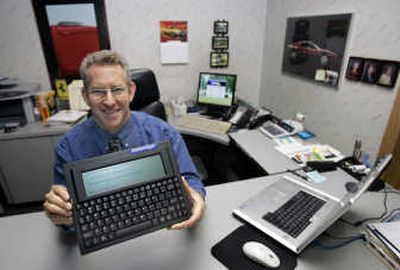Devices aid deaf customers

Five years ago the staff at Ken Gan’s auto repair shop told him they needed to find a better way of communicating with customers who were deaf.
“I said, let me go shopping – I’ll buy you whatever’s out there,” said Gan, of Rochester, N.Y., which has a significant community of deaf people.
For three months, Gan came up empty-handed. There wasn’t anything in the market to facilitate face-to-face communication in a situation such as a shop or office.
So Gan hired some electrical engineers and a patent attorney and came up with the Interpretype. The small device with a keyboard and display hooks up to another Interpretype or a PC, allowing a hearing person and a deaf person to type messages to each other. It turned out to be such an improvement over passing scribbled notes that Gan gets up to 30 deaf customers a month, up from two to three per month before.
Gan started a business above the shop that has sold more than a thousand Interpretypes to schools, libraries, government offices and businesses. The basic setup starts at $995.
With roughly 1 percent to 2 percent of the U.S. population either deaf or hard of hearing, new technologies like Gan’s device are coming into wider use. They allow deaf people to overcome many frustrations in simple commercial situations such as asking: What’s wrong with my car?
Or if you want to rent a car. James Barons, manager of an Enterprise Rent-a-Car branch in Rochester, said he’s seen interactions with deaf customers improve markedly after installing one of Gan’s text-exchange devices.
“It made the whole transaction of renting a car a lot smoother,” Barons said.
Other technologies are also making inroads in bridging the gap between hearing people and the deaf.
Jason Curry founded a company in Independence, Mo., with his father that makes a communications device similar to the Interpretype. The UbiDuo uses two portable units, connected by wireless technology. A pair, which can be folded together, starts at $1,995.
Curry has already sold hundreds since starting sales at the beginning of the year and expects to sell several thousand next year. He said he’s talking with Starbucks Corp. about getting UbiDuos installed in coffee shops.
Curry, who is deaf, said that he was able to directly communicate with his wife’s family for the first time last Christmas by using one of the devices. Not having his wife interpret was a “life-changing experience” for him, he said.
“Deaf people have a lack of power to sit down across from a hearing person and have a conversation without a third party interpreting for them,” Curry said through a sign language interpreter.
Another technology that has seen even greater growth in recent years is the video relay service, which allows a deaf person to telephone a hearing person using a sign language interpreter. The interpreter and the deaf person communicate in sign language using a broadband video connection, while the interpreter speaks with the hearing person over a speakerphone.
Deaf people say video relay services mark a major improvement over the previous telephone method available, which involved an operator reading text that a deaf person would type into a device called a TTY – a technology more than 20 years old that exchanged basic text over phone lines using a modem.
Norman Williams, a senior research engineer at Gallaudet University, a school for the deaf and hard-of-hearing in Washington, D.C., uses a video phone every day for a variety of calls including talking to his kids’ teachers, arranging doctors’ visits or ordering pizza.
“I can’t imagine living without it,” Williams said in an interview using a video relay service. “Before we could use TTY, but that’s a really slow process. Right now I can sign, just like somebody is speaking, so it’s more like real-time conversation.”
Video relay services have only come into common use in the past three years or so, and usage is growing rapidly, having jumped from about 1 million minutes per month in August 2004 to about 6 million minutes in August of this year, according to the National Exchange Carrier Association.
Under federal law, phone companies are required to offer those and other telecommunications services for people with disabilities, funded by the charges at the bottom of your phone bill.